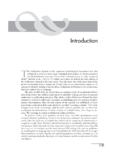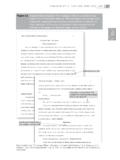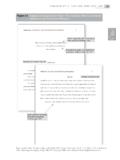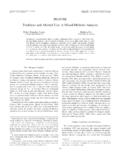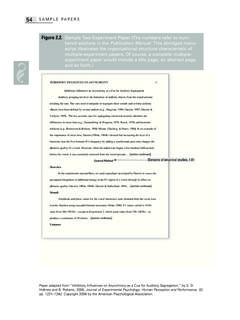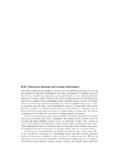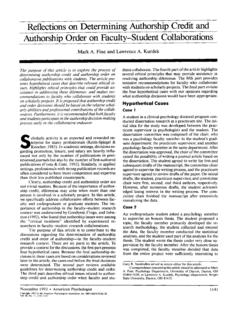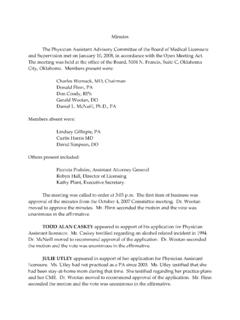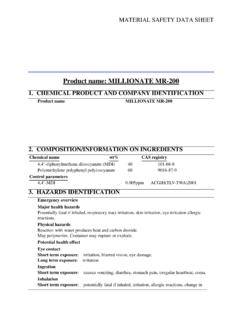Transcription of The Explosion of Knowledge, References, and …
1 The Explosion of knowledge , References, and citations Psychology's Unique Response to a Crisis John G. Adair University of Manitoba Neharika Vohra Indian Institute of Management, Ahmedabad, India The knowledge Explosion has created enormous difficulties and funds could no longer maintain holdings of all new for researchers to be aware of, access, and process the journals. This problem is being addressed by libraries pool- volume of new literature. Electronic literature retrieval ing resources and by increasing electronic availability of systems and specialization on narrow topics have been full-text journal articles.
2 The third problem that researchers strategies used to cope with these problems. In this study, have had to face is reading and processing all of the new the authors examined the additional effects of the knowl- information. Within psychology, Thorngate (1990) pre- edge Explosion on researchers' writing, referencing, and dicted researchers would choose to read narrowly within citing. Counts of references within sampled empirical jour- their research interest, summaries rather than in-depth nal articles in sociology, physics, biology, and experimen- or complete works, current literature to the exclusion of the tal and social psychology revealed impacts of the knowl- older classics, and primarily writings by famous persons edge Explosion in all disciplines but the greatest effects or articles with catchy titles.
3 Indeed, specialization has within psychology. Detailed analyses indicated that sub- become commonplace in both teaching and research stantial changes in the numbers of references and citations (Moghaddam, 1997). and in their format and use within the research article are The fourth problem is how researchers can cope with psychology's unique response to the knowledge Explosion . the large volume of literature within their own writing. The prospect of a literature Explosion leading to changes in the nature of research reports, especially in the number and T he information Explosion is upon us! In academia, form of cited references, has yet to be addressed.
4 Two sets the phenomenon has taken the form of a knowledge of data collected for entirely different purposes have pro- Explosion . Estimates of its magnitude vary, but all vided preliminary evidence of changes in published psy- leave the reader with the impression of a seemingly uncon- chological research. Vohra and Adair (1991) reported an trollable expansion of research literature. Price (1961) ob- expanding discrepancy emerging between developed and served in the early 1950s that the scientific literature had developing countries in the average number of references been increasing exponentially. The number of abstracts cited in research articles, resulting primarily from dramatic published by the 12 leading publishers of secondary scien- increases in the numbers of references cited by developed- tific information (the American Psychological Association world psychologists.)
5 Reis and Stiller (1992) found a strik- [APA] is one of these) had increased from about 555,000 in ing threefold increase in the number of references per study 1957 to million in 1977 and million in 1997 in the Journal of Personality and Social Psychology (JPSP). (Kaser, 1998)! In psychology, publishers have subdivided journals, increased the number of issues per year of some Editor's note. Gary R. VandenBos served as action editor for this article. journals, and added new multidisciplinary and specialized journals to an ever-increasing scientific literature. Thorn- Author's note. John G. Adair, Department of Psychology, University of gate (1990) estimated that psychologists were publishing Manitoba; Neharika Vohra, Indian Institute of Management, Ahmedabad, articles at the rate of about 100 per day, about one every India.
6 15 minutes (p. 262). This research was supported by grants to John G. Adair from the The knowledge Explosion has generated four prob- Social Sciences and Humanities Research Council of Canada. The project was begun while Neharika Vohra was a doctoral student in psychology at lems for researchers who must monitor published articles the University of Manitoba. The authors are indebted to Teddy Andres, for incremental new knowledge as the basis for their orig- Chantal Arpin, Jessica Cameron, Angela Coehlo, Matthew Derksen, Kim inal research. The first problem is how a researcher is to Grenier, Joelle Kobylak, Sophia Macrodimitris, and Helen Williams, who maintain awareness of all the relevant new literature.
7 This assisted with the data collection, and John G. Eales (zoology) and Gwyn was soon addressed by electronic databases that indexed Williams (physics), who provided advice on the journals and referencing practices in their respective disciplines. the published literature by bibliographic reference and ci- Correspondence concerning this article should be addressed to John tations (Garfield, 1955). Access to the literature became the G. Adair, Department of Psychology, University of Manitoba, Winnipeg, second problem for researchers as libraries limited in space MB R3T 2N2, Canada. January 2003 American Psychologist 15.
8 Copyright 2003 by the American Psychological Association, Inc. 0003-066X/03/$ Vol. 58, No. 1, 15 23 DOI: function of the discipline's relative dependence on either the current or the classical literature. Innes (1973) reported that within the Journal of Ex- perimental Psychology (JEP) for the years 1945, 1955, and 1965, 40% of the references were to articles less than five years old. Xhignesse and Osgood (1967) observed in more than 20 different psychology journals that the proportion of citations to the current literature was large and had in- creased over the previous decade. Both of these data sets were from the periods well before the recent expansion in research literature.
9 Study 1 was undertaken to address basic questions about the scholarly response to the knowledge Explosion over the past several decades. These data would enable us to determine whether the number of references per article continued to rise, the percentage of the referenced literature that was current had increased, the older research literature had begun to be ignored, and referencing differed in amount or pattern within subfields of psychology. To test whether changes in referencing practices were unique to John G. psychology, we selected three distinctly different disci- Adair plines for comparative analysis.
10 Method General procedure. References were counted over the previous three decades. The data from both studies within each sampled empirical article for the periods 1972 . suggested that the effects of the knowledge Explosion ex- 1974, 1978 1980, 1984 1986, 1990 1992, 1996 1998, tended beyond simply keeping up with the volume of and 2000. These dates and intervals were selected within literature to altering the format and text of new research the context of previous studies (J. G. Adair, Puhan, &. articles. Vohra, 1993; Vohra & Adair, 1991), extended through In this article, we report data collected to assess psy- 1996 1998, and brought up to date by the inclusion of data chology's response to the knowledge Explosion in compar- for the year 2000.
